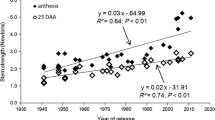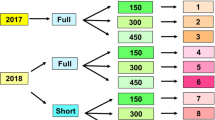Abstract
Selection for lodging resistant cultivars in cereal breeding programs is difficult due to the challenge of screening for this trait under natural field conditions. The identification of easily measurable culm traits related to lodging resistance would simplify the selection process. The present study was conducted to determine if differences in culm anatomy exist among modern wheat genotypes differing in lodging susceptibility, and to determine the association between culm characters and lodging. From a 2-year field study conducted in Edmonton, Alberta, 13 spring wheat cultivars were chosen based on predetermined susceptibility to artificially induced lodging. Morphological and anatomical culm measurements were made visually and with an environmental scanning electron microscope. Genotypes differed (P < 0.05) for plant height, number of internodes per culm, basal internode length and diameter, culm wall thickness and the number of vascular bundles, but not for adventitious root frequency, lumen diameter or sclerenchyma ring thickness. Mean genotype field scores for artificially induced lodging were correlated (P < 0.05) with plant height (r= 0.51) and the length of the fourth basal internode (r= 0.51). Short, wide basal internodes and thick culm walls were characteristic of three lodging tolerant genotypes: Kohika, Sapphire and Olso. Nevertheless, despite such apparent genotype specific association between culm anatomy and field lodging, general applicable associations were not observed for most traits. The most practical and easily selectable trait for lodging resistance within a wheat breeding program remains plant height.
Similar content being viewed by others
References
Alberta Agriculture, Food & Rural Development (AAFRD), 2002a. Crop Protection. Agdex no. 606-1. Alberta Agriculture, Food & Rural Development, Edmonton, Alberta, Canada.
Alberta Agriculture, Food & Rural Development (AAFRD), 2002b. Varieties of Cereal and Oilseed Crops for Alberta. Agdex no. 100-32. Alberta Agriculture, Food & Rural Development, Edmonton, Alberta, Canada.
Berry, P.M., J.M. Griffin, R. Sylvester-Bradley, R.K. Scott, J.H. Spink, C.J. Baker & R.W. Clare, 2000. Controlling plant form through husbandry to minimise lodging in wheat. Field Crops Res 67: 51–58.
Brady, J., 1934. Some factors influencing lodging in cereals. J Agric Sci (Cambridge) 24: 209–232.
Briggs, K.G., 1990. Studies of recovery from artificially induced lodging in several six-row barley cultivars. Can J Plant Sci 70: 173–181.
Cox, T.S., J.P. Shroyer, L. Ben-Hui, R.G. Sears & T.J. Martin, 1988. Genetic improvement in agronomic traits of hard red winter wheat cultivars from 1919 to 1987. Crop Sci 28: 756–760.
Crook, M.J. & A.R. Ennos, 1994. Stem and root characteristics associated with lodging resistance in four winter wheat genotypes. J Agric Sci (Cambridge) 123: 167–174.
Danilatos, G.D., 1993. Introduction to the ESEM instrument. Microsc Res Tech 25: 354–361.
DePauw, R. & T. Hunt, 2001. Canadian wheat pool. In: A.P. Bonjean & W.J. Angus (Eds.), TheWorld Wheat Book:AHistory of Wheat Breeding, pp. 479–515. Lavoisier Publishing, Paris, France.
Dunn, G.J. & K.G. Briggs, 1989. Variation in culm anatomy among barley genotypes differing in lodging resistance. Can J Bot 67: 1838–1843.
Easson, D.L., E.M. White & S.L. Pickles, 1993. The effects of weather, seed rate and genotype on lodging and yield in winter wheat. J Agric Sci (Cambridge) 121: 145–156.
Fehr, W.R., 1987. Principles of Genotype Development, Volume 1. Macmillan, New York.
Fischer, R.A. & M. Stamper, 1987. Lodging effects on high-yielding corps of irrigated semidwarf wheat. Field Corps Res 17: 245–258.
Fischer, R.A. & P.C. Wall, 1976. Wheat breeding in Mexico and yield increases. J Aust Inst Agric Sci 42: 139–148.
Hamilton, D.G., 1941. Certain oat culm characters and their relationship to lodging. Sci Agric 21: 646–676.
Jedel, P.E. & J.H. Helem, 1991. Lodging effects on a semidwarf and two standard barley cultivars. Agron J 83: 158–161.
Jellum, M.D., 1962. Relationships between lodging resistance and certain culm characters in oats. Crop Sci 2: 263–267.
Johansen, D.A., 1940. Microchemical methods. In: Plant Microtechnique, 1st ed., pp. 194, McGraw-Hill, New York.
Kelbert, A.J., D. Spaner, K.G. Briggs & J.R. King, 2004. Screening for lodging resistance in spring wheat breeding programs. Plant Breeding. in press.
Keller, M., C. Karutz, J.E. Schmid, P. Stamp, M.Winzeler, B. Keller & M.M. Messmer, 1999. Quantitative trait loci for lodging resistance in a segregating wheat × spelt population. Theor Appl Genet 98: 1171–1182.
Laude, H.H. & A.W. Pauli, 1956. Influence of lodging on yield and other characters in winter wheat. Agron J 48: 452–455.
Minnesota Agricultural Experiment Station (MAES), 2002. Reeder hard red spring wheat. University of Minnesota Extension Service, St. Paul, MN.
McCaig,T.N. & R.M. DePauw, 1994. Breeding hard red spring wheat in western Canada: Historical trend in yield and related variables. Can J Plant Sci 75: 387–393.
Morrison, J.W., 1960. Marquis wheat—a triumph of scientific endeavour. Agric Hist 34: 182–188.
Mukherjee, K.K., S.P. Kohli & K.L. Sethi, 1967. Lodging resistance in wheat. Indian J Agron 12: 56–61.
Murthy, B.N. & M.V. Rao, 1980. Evolving suitable index for lodging resistance in barley. Indian J Genet Plant Breed 40: 253–261.
NewZealand Crop & Food Research (NZCFR), 2000.Kohika wheat, Broad Sheet no. 85. New Zealand Institute of Crop & Food Research Limited, Christchurch, New Zealand.
Pinthus, M.J., 1973. Lodging in wheat, barley, and oats: The phenomenon, its causes, and preventative measures. Adv Agron 25: 210–256.
SAS Institute, 1989. SAS/STAT User's Guide, Version 6, Volume 2, 4th ed. SAS Institute, Inc., Cary, NC.
Stanca, A.M., G. Jenkins & P.R. Hanson, 1979. Varietal responses in spring barley to natural and artificial lodging and to a growth regulator. J Agric Sci (Cambridge) 93: 440–456.
Stapper, M. & R.A. Fischer, 1990. Genotype, sowing date and plant spacing influence on high-yielding irrigated wheat in Southern New South Wales. II: Growth, yield and nitrogen use. Aust J Agric Res 41: 1021–1041.
Steel, R.G.D., J.H. Torrie & D.A. Dickey, 1997. Principles and Procedures of Statistics: A Biometrical Approach, 3rd ed. McGraw-Hill, New York.
Tandon, J.P., K.B. Jain & S.B. Singh, 1973. Relationship between lodging resistance and some morphological characters in barley. Indian J Genet Plant Breed 33: 347–354.
Weibel, R.O. & J.W. Pendleton, 1964. Effect of artificial lodging on winter wheat grain yield and quality. Agron J 56: 487–488.
Worland, T. & J.W. Snape, 2001. Genetic control of plant stature. In: A.P. Bonjean & W.J. Angus (Eds.), The World Wheat Book: A History of Wheat Breeding, pp. 67–71. Lavoisier Publishing, Paris, France.
Zadoks, J.C., T.T. Chang & C.F. Konzak, 1974. A decimal code for the growth stages of cereals. Weed Res 14: 415–421.
Zuber, U., H. Winzeler, M.M. Messmer, M. Keller, B. Keller, J.E. Schmid & P. Stamp, 1999. Morphological traits associated with lodging resistance of spring wheat (Triticum aestivum L.). J Agron Crop Sci 182: 17–24.
Author information
Authors and Affiliations
Rights and permissions
About this article
Cite this article
Kelbert, A., Spaner, D., Briggs, K. et al. The association of culm anatomy with lodging susceptibility in modern spring wheat genotypes. Euphytica 136, 211–221 (2004). https://doi.org/10.1023/B:EUPH.0000030670.36730.a4
Issue Date:
DOI: https://doi.org/10.1023/B:EUPH.0000030670.36730.a4




